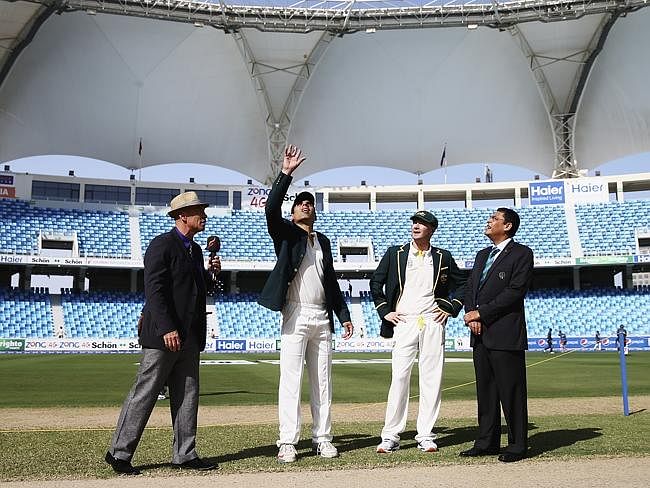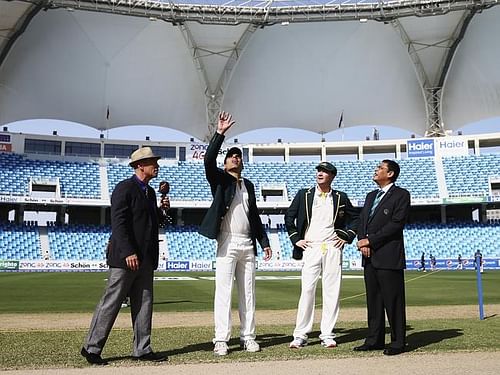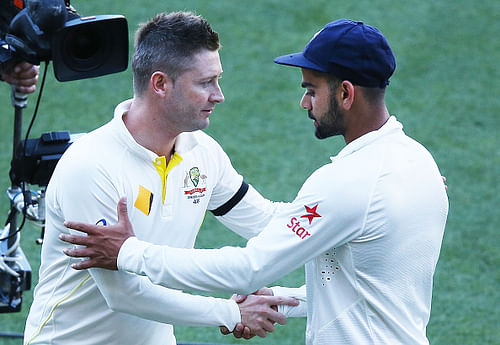
What if Test cricket had an IPL-style tournament

Over the past few years, the fact that Test cricket has been struggling in its quest for prominence has been palpable to one and all, with a large majority of Test matches in modern-day cricket witnessing grossly sparse crowds.
The one obvious exception is the Ashes, where spectator interest is perhaps as high as it’s ever been. Last year’s Ashes Test at the iconic Melbourne Cricket Ground (MCG), for example, saw a record attendance of 91,092 spectators on day one. Due to the rich and long-standing tradition involved in contests between Australia and England, Ashes Tests will continue to garner plenty of interest among cricket lovers not just in the two countries but around the world in the years to come.
But if we assume that the primacy of Test cricket is intact on the basis of the hype and anticipation that surround Ashes battles, I’m afraid we are being lulled into a false sense of security. This might consequently have serious repercussions on the long-term future of the game.
One of the major reasons for the interest in Test cricket dwindling of late has been the booming rise of T20 cricket since its introduction at the international level in 2005. India’s win in the inaugural World T20 in 2007 certainly went a long way towards accelerating the growth of the shortest format. However, the inclination of an ingenious Lalit Modi to make optimal use of the buzz that the format created should not be underestimated.
To be fair to the International Cricket Council (ICC), they have taken cognizance of the fight for relevance that Test cricket is seemingly facing today, and have tried to reinvigorate the five-day game by proposing the idea of a Test Championship. However, nothing concrete has emerged on that front until now, with the logistics of such a championship being a major hindrance in it going ahead.
With the Test championship being on hold for the time being, could the ICC look at another alternative? With the enormous role that various T20 leagues have played in elevating the ‘brand’ of T20 cricket, I’ve often wondered whether something similar could be done for the 5-day game.
If a Test league was to be conceived, here’s how it could possibly work:
Considering the time span of a Test match as well as the cramped international calendar, a four-team league lasting for a couple of months would be prudent.
With due respect to the other Test playing nations in the world, it would be fair to say that India, Australia, England and South Africa have been the pre-eminent teams in Test cricket since the year 2000, and hence, the league would be centred around these four teams. The fact that they are the most marketable out of the lot, which would help the league in attracting viewer interest and sponsors, does no harm either.
The league stage would see the four teams going head to head against each other once each before the final.
Schedule
(Note: For the sake of convenience, I’ve overlooked the current schedule of the IPL while coming up with the following schedule, as April and May are currently the only two months in the year when a vast majority of the top international players are not bound by any international commitments).
| Date | Matches |
|---|---|
| Apr 1-5 | India Invincibles v Australia Aces |
| Apr 7-11 | Australia Aces v Proteas Panthers |
| Apr 13-17 | India Invincibles v England Eagles |
| Apr 21-25 | England Eagles v Proteas Panthers |
| May 1-5 | India Invincibles v Proteas Panthers |
| May 7-11 | Australia Aces v England Eagles |
| May 21-25 | TBD v TBD |
Points
| Result | Points |
|---|---|
| Outright win | 10 |
| Tie | 0 |
| Outright loss | 5 |
| Abandoned or drawn match | 2 |
*In the case of a draw in the final, the team with the first innings lead will claim the title.
Bonus points
(For the batting and bowling bonus points mentioned below, only the first 100 overs of the first innings will be taken into account)
Batting
| Runs | Points |
|---|---|
| 200-249 | 1 |
| 250-299 | 2 |
| 300-349 | 3 |
| 350-399 | 4 |
| 400 or above | 5 |
Bowling
| Wickets | Points |
|---|---|
| 4-5 | 1 |
| 6-8 | 3 |
| 9-10 | 5 |
Teams
Each team should have a minimum of eight local players in their squad of 15 and at least six local players in the playing XI.
Because of the way the league is structured, the squads to a large extent will obviously constitute players from India, Australia, England and South Africa. However, the very best players from teams like Pakistan and New Zealand will also feature, thereby enhancing the quality of the competition.
Host country
To ensure fairness, the league would be hosted by a different participating country every year, thereby giving each team the opportunity to play in the conditions most suitable to them at least once every four years.
Squads

It would be too far-fetched for me to come up full-fledged squads for each of the four sides. Instead, here are five domestic players that each participating team will consider must-haves:
India Invincibles:
Murali Vijay
The 30-year-old Murali Vijay has firmly established himself as India’s Test opener over the last 12 months with impressive displays in South Africa, England and Australia, and will probably be one of the first names on the team-sheet for a world Test XI currently.
Virat Kohli
With his twin hundreds in Adelaide, Virat Kohli has emphatically proved that the terrible run he endured in England was nothing more than an aberration. One of the best batsmen in world cricket today, it’ll be a travesty if he doesn’t end up with 10,000 Test runs by the time he calls it a day.
MS Dhoni
MS Dhoni, quite simply, is the greatest wicketkeeper-batsman India has ever produced. Rightly or wrongly, he has been on the receiving end of scathing criticism for his captaincy in Test cricket overseas for a majority of the last two or three years.
While some of the criticism is justified, what I will say is that his performances with the bat in England recently exhibited a certain determination which suggests that he still has a few good years at the top level ahead of him.
Ajinkya Rahane
Perhaps India’s most improved player of late, Ajinkya Rahane was known as a heavy run-scorer in domestic cricket for Mumbai before his foray into international cricket, and he has certainly translated those run-making attributes into the highest level as well.
Ishant Sharma
Few Indian cricketers have been derided as much as Ishant Sharma has since his Test debut in 2007, in my opinion. The reason for the criticism being that, despite making his debut for India seven years ago, he struggled to make his experience count and take up the mantle of performing like a senior bowler.
The Indian selectors, however, persisted with him, and it’s started to pay dividends recently. His match-winning spell of 7/74 in the 2nd innings against England at Lord’s in July, 2014, will go down in history as one of the best spells of fast bowling ever seen by an Indian fast bowler.
Australia Aces:
David Warner
David Warner started off as somewhat of a T20 specialist, but his transformation into a Test batsman who is capable of notching up big scores has been remarkable to say the least. Since the start of the home Ashes last year, he has scored 1,552 runs from 12 Tests at an average of 73.90, including 8 half-centuries and 5 centuries.
Steven Smith
The fact that 25-year-old Steven Smith, despite being just 23 Tests old, has been appointed Australian captain for the ongoing India series in Michael Clarke’s absence illustrates how highly he is rated by the Australian selectors. He started his career as a leg-spinner who could bat a bit, but that’s certainly changed in the last couple of years. From his 23 Tests, he has racked up close to 2000 runs a 46.02.
Michael Clarke
While his injuries have put into doubt how long he can carry on as a Test cricketer, his ability hasn’t deteriorated whatsoever, with him still undisputedly being Australia’s best longer format batsman.
Mitchell Johnson
Awarded the ICC Cricketer of the Year for his noteworthy achievements over the course of the last 12 months, it wouldn’t be unfair to opine that the left-arm quick was single-handedly responsible for Australia’s 5-0 drubbing of the Poms last summer.
Mitchell Marsh
While Mitchell Marsh is still very much a greenhorn in terms of international cricket, there is very little doubt of his long-term potential, glimpses of which he’s already shown. He is already an incumbent in all the three formats of the game for Australia, and it’d be fair to say he’s growing in stature with each passing game.
England Eagles:
Alastair Cook
One of the modern Test match greats, Alastair Cook, at the age of 29, has already amassed 8,423 runs from 109 Tests at 46.02, and he should be adding truckloads to that tally in the years to come.
Ian Bell
Ian Bell, considering the talent he’s been blessed with, should’ve perhaps achieved a lot more in his Test career than he has managed until now. Given the fact that he has more than 7000 runs to his name in the 105 Tests he’s played, however, only goes to show the high esteem he is held in, not just in England but also around the world.
James Anderson
England have had the good fortune of possessing plenty of outstanding fast bowlers in their 137-year-old Test history. With that being the case, James Anderson being just four wickets shy of becoming England’s all-time leading wicket-taker in Test cricket tells you all you need to know of his infinite class and ability.
Stuart Broad
Although forming a deadly partnership with James Anderson over the years, Stuart Broad might not have taken wickets at as healthy a strike-rate as his senior partner. But he certainly makes amends for his occasional profligacy by providing crucial breakthroughs for his country when they need them most.
From 74 Tests, he has picked up 264 scalps at an average just under 30.
Joe Root
One of the most promising young batsmen in the world today, Joe Root is only going to get better as he plays more and more of international cricket. He has already shown flashes of his enormous talent, leading to him already being earmarked as the next England captain, with his 154* against India at Trent Bridge when his team were in a precarious position being one of the highlights for English cricket this year.
Proteas Panthers:
AB de Villiers
The best batsman in the world today, AB de Villiers’ wizardry with the bat in hand is quite simply unmatched in the modern game. Blessed with a gift of timing, South Africa are heavily dependent on his runs across all the three formats, and seldom does he disappoint.
Dale Steyn
We, as cricket fans, are extremely fortunate that South Africa’s Dale Steyn plies his trade in the current era as opposed to any other. With a staggering 383 Test wickets from 75 games, his record is capable of standing the test of time, and I’ve no doubt in my mind that he’ll be remembered in time to come as one of the greatest fast bowlers to have ever graced the cricket field.
Hashim Amla
The backbone of South Africa’s batting unit in the last few years, Hashim Amla deserves great credit for the consistent performances he’s put in at the top of the order. It might seem strange now, but he actually started off his Test career with a big question mark hanging over his technique. However, he has dispelled all his doubters courtesy of scoring a truckload of runs all around the world, an increasingly rare phenomenon in modern-day cricket.
Morne Morkel
Morne Morkel, by all accounts, is one of the nicest blokes you could come across off the cricketing field. However, he seems anything but whenever he has the brand new cherry in his hand. Blessed with the ability to generate steep bounce from short of a good length, Morkel has been an able backup to Steyn over the years with 204 wickets from 59 Tests at just under 30.
Faf du Plessis
With the retirements of Jacques Kallis and Graeme Smith, Faf du Plessis has been given the onerous task of batting at No.3 in Test match cricket. Based on what we have seen in his relatively short Test career, he is certainly capable of fulfilling those expectations. He burst onto the scene with a match-saving 110* in the 2nd innings against Australia back in 2012, and his career has only grown in stature since.
Foresight and conviction necessary
Just recently, the first Test between Australia and India came to a nail-biting conclusion with India losing by an agonizing margin of 48 runs despite a dazzling century by stand-in skipper Kohli on day five. The quality of play on view enchanted everyone watching and also reaffirmed the fact that T20 cricket, despite all its glitz and glamour, can seldom match up to a top quality Test match contest.
However, the fact that just a relatively meagre 24,000 (approx.), out of a capacity of over 50,000, attended what was an exhilarating final day’s play, clearly indicates the problem at hand.
Finally, while such a seemingly radical league for the longer format might seem unrealistic and even foolhardy at present, a bit of foresight and conviction could help trigger the revival of Test cricket that we all have been long waiting for, and wipe out the general apathy of the public towards the 5-day game.